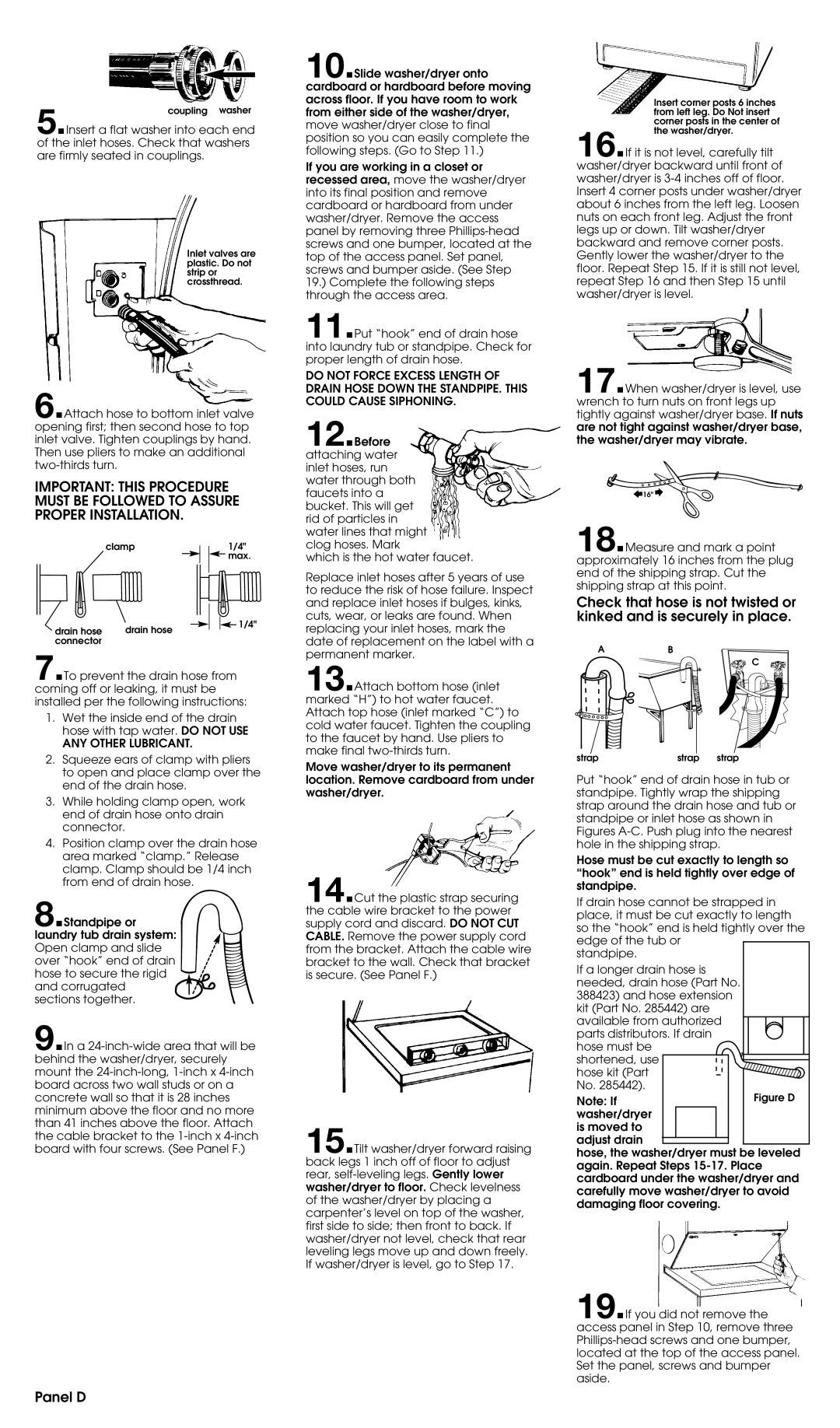
coupling washer
5.Insert a flat washer into each end of the inlet hoses. Check that washers are firmly seated in couplings.
Inlet valves are plastic. Do not strip or crossthread.
6.Attach hose to bottom inlet valve opening first; then second hose to top inlet valve. Tighten couplings by hand. Then use pliers to make an additional
IMPORTANT: THIS PROCEDURE MUST BE FOLLOWED TO ASSURE PROPER INSTALLATION.
clamp |
|
| 1/4" | |
| ||||
|
|
|
| max. |
|
|
|
| |
10.Slide washer/dryer onto cardboard or hardboard before moving across floor. If you have room to work from either side of the washer/dryer, move washer/dryer close to final position so you can easily complete the following steps. (Go to Step 11.)
If you are working in a closet or recessed area, move the washer/dryer into its final position and remove cardboard or hardboard from under washer/dryer. Remove the access panel by removing three
11.Put “hook” end of drain hose into laundry tub or standpipe. Check for proper length of drain hose.
DO NOT FORCE EXCESS LENGTH OF DRAIN HOSE DOWN THE STANDPIPE. THIS COULD CAUSE SIPHONING.
12.Before attaching water inlet hoses, run water through both faucets into a bucket. This will get rid of particles in water lines that might clog hoses. Mark
which is the hot water faucet.
Insert corner posts 6 inches from left leg. Do Not insert corner posts in the center of the washer/dryer.
16.If it is not level, carefully tilt washer/dryer backward until front of washer/dryer is
17.When washer/dryer is level, use wrench to turn nuts on front legs up tightly against washer/dryer base. If nuts are not tight against washer/dryer base, the washer/dryer may vibrate.
16"![]()
18.Measure and mark a point approximately 16 inches from the plug
drain hose drain hose connector
1/4"
Replace inlet hoses after 5 years of use to reduce the risk of hose failure. Inspect and replace inlet hoses if bulges, kinks, cuts, wear, or leaks are found. When replacing your inlet hoses, mark the date of replacement on the label with a permanent marker.
end of the shipping strap. Cut the shipping strap at this point.
Check that hose is not twisted or kinked and is securely in place.
AB
7.To prevent the drain hose from coming off or leaking, it must be installed per the following instructions:
1.Wet the inside end of the drain hose with tap water. DO NOT USE ANY OTHER LUBRICANT.
2.Squeeze ears of clamp with pliers to open and place clamp over the end of the drain hose.
3.While holding clamp open, work end of drain hose onto drain connector.
4.Position clamp over the drain hose area marked “clamp.” Release clamp. Clamp should be 1/4 inch from end of drain hose.
8.Standpipe or laundry tub drain system: Open clamp and slide over “hook” end of drain hose to secure the rigid and corrugated sections together.
9.In a
13.Attach bottom hose (inlet marked “H”) to hot water faucet. Attach top hose (inlet marked “C”) to cold water faucet. Tighten the coupling to the faucet by hand. Use pliers to make final
Move washer/dryer to its permanent location. Remove cardboard from under washer/dryer.
14.Cut the plastic strap securing the cable wire bracket to the power supply cord and discard. DO NOT CUT CABLE. Remove the power supply cord from the bracket. Attach the cable wire bracket to the wall. Check that bracket is secure. (See Panel F.)
15.Tilt washer/dryer forward raising back legs 1 inch off of floor to adjust rear,
![]()
![]()
![]() C
C
strap | strap | strap |
Put “hook” end of drain hose in tub or standpipe. Tightly wrap the shipping strap around the drain hose and tub or standpipe or inlet hose as shown in Figures
Hose must be cut exactly to length so “hook” end is held tightly over edge of standpipe.
If drain hose cannot be strapped in place, it must be cut exactly to length so the “hook” end is held tightly over the edge of the tub or
standpipe.
If a longer drain hose is |
|
needed, drain hose (Part No. |
|
388423) and hose extension |
|
kit (Part No. 285442) are |
|
available from authorized |
|
parts distributors. If drain |
|
hose must be |
|
shortened, use |
|
hose kit (Part |
|
No. 285442). | Figure D |
Note: If | |
washer/dryer |
|
is moved to |
|
adjust drain |
|
hose, the washer/dryer must be leveled again. Repeat Steps
19.If you did not remove the access panel in Step 10, remove three
